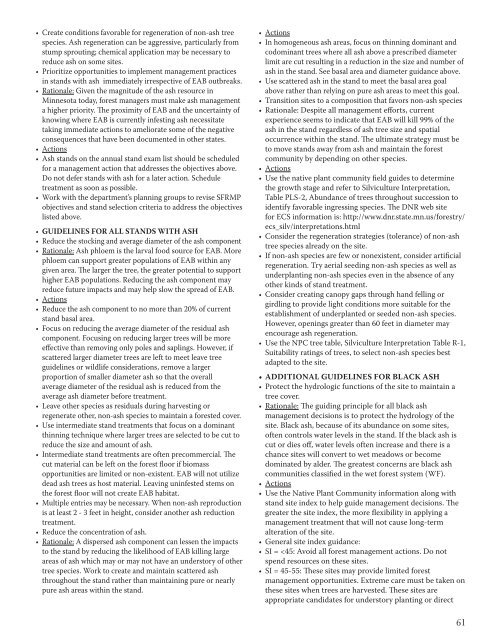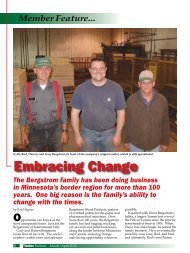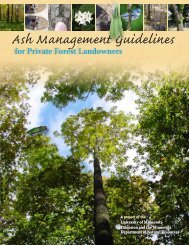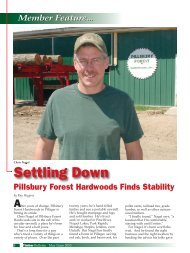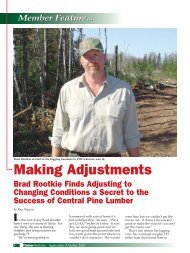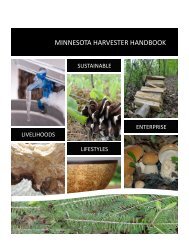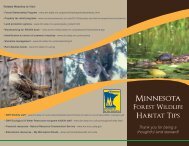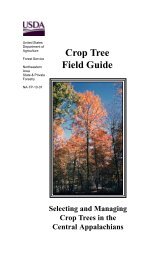Ash Management Guide for Private Forest Landowners
Ash Management Guide for Private Forest Landowners
Ash Management Guide for Private Forest Landowners
Create successful ePaper yourself
Turn your PDF publications into a flip-book with our unique Google optimized e-Paper software.
• Create conditions favorable <strong>for</strong> regeneration of non-ash treespecies. <strong>Ash</strong> regeneration can be aggressive, particularly fromstump sprouting; chemical application may be necessary toreduce ash on some sites.• Prioritize opportunities to implement management practicesin stands with ash immediately irrespective of EAB outbreaks.• Rationale: Given the magnitude of the ash resource inMinnesota today, <strong>for</strong>est managers must make ash managementa higher priority. The proximity of EAB and the uncertainty ofknowing where EAB is currently infesting ash necessitatetaking immediate actions to ameliorate some of the negativeconsequences that have been documented in other states.• Actions• <strong>Ash</strong> stands on the annual stand exam list should be scheduled<strong>for</strong> a management action that addresses the objectives above.Do not defer stands with ash <strong>for</strong> a later action. Scheduletreatment as soon as possible.• Work with the department’s planning groups to revise SFRMPobjectives and stand selection criteria to address the objectiveslisted above.• GUIDELINES FOR ALL STANDS WITH ASH• Reduce the stocking and average diameter of the ash component• Rationale: <strong>Ash</strong> phloem is the larval food source <strong>for</strong> EAB. Morephloem can support greater populations of EAB within anygiven area. The larger the tree, the greater potential to supporthigher EAB populations. Reducing the ash component mayreduce future impacts and may help slow the spread of EAB.• Actions• Reduce the ash component to no more than 20% of currentstand basal area.• Focus on reducing the average diameter of the residual ashcomponent. Focusing on reducing larger trees will be moreeffective than removing only poles and saplings. However, ifscattered larger diameter trees are left to meet leave treeguidelines or wildlife considerations, remove a largerproportion of smaller diameter ash so that the overallaverage diameter of the residual ash is reduced from theaverage ash diameter be<strong>for</strong>e treatment.• Leave other species as residuals during harvesting orregenerate other, non-ash species to maintain a <strong>for</strong>ested cover.• Use intermediate stand treatments that focus on a dominantthinning technique where larger trees are selected to be cut toreduce the size and amount of ash.• Intermediate stand treatments are often precommercial. Thecut material can be left on the <strong>for</strong>est floor if biomassopportunities are limited or non-existent. EAB will not utilizedead ash trees as host material. Leaving uninfested stems onthe <strong>for</strong>est floor will not create EAB habitat.• Multiple entries may be necessary. When non-ash reproductionis at least 2 - 3 feet in height, consider another ash reductiontreatment.• Reduce the concentration of ash.• Rationale: A dispersed ash component can lessen the impactsto the stand by reducing the likelihood of EAB killing largeareas of ash which may or may not have an understory of othertree species. Work to create and maintain scattered ashthroughout the stand rather than maintaining pure or nearlypure ash areas within the stand.• Actions• In homogeneous ash areas, focus on thinning dominant andcodominant trees where all ash above a prescribed diameterlimit are cut resulting in a reduction in the size and number ofash in the stand. See basal area and diameter guidance above.• Use scattered ash in the stand to meet the basal area goalabove rather than relying on pure ash areas to meet this goal.• Transition sites to a composition that favors non-ash species• Rationale: Despite all management ef<strong>for</strong>ts, currentexperience seems to indicate that EAB will kill 99% of theash in the stand regardless of ash tree size and spatialoccurrence within the stand. The ultimate strategy must beto move stands away from ash and maintain the <strong>for</strong>estcommunity by depending on other species.• Actions• Use the native plant community field guides to determinethe growth stage and refer to Silviculture Interpretation,Table PLS-2, Abundance of trees throughout succession toidentify favorable ingressing species. The DNR web site<strong>for</strong> ECS in<strong>for</strong>mation is: http://www.dnr.state.mn.us/<strong>for</strong>estry/ecs_silv/interpretations.html• Consider the regeneration strategies (tolerance) of non-ashtree species already on the site.• If non-ash species are few or nonexistent, consider artificialregeneration. Try aerial seeding non-ash species as well asunderplanting non-ash species even in the absence of anyother kinds of stand treatment.• Consider creating canopy gaps through hand felling orgirdling to provide light conditions more suitable <strong>for</strong> theestablishment of underplanted or seeded non-ash species.However, openings greater than 60 feet in diameter mayencourage ash regeneration.• Use the NPC tree table, Silviculture Interpretation Table R-1,Suitability ratings of trees, to select non-ash species bestadapted to the site.• ADDITIONAL GUIDELINES FOR BLACK ASH• Protect the hydrologic functions of the site to maintain atree cover.• Rationale: The guiding principle <strong>for</strong> all black ashmanagement decisions is to protect the hydrology of thesite. Black ash, because of its abundance on some sites,often controls water levels in the stand. If the black ash iscut or dies off, water levels often increase and there is achance sites will convert to wet meadows or becomedominated by alder. The greatest concerns are black ashcommunities classified in the wet <strong>for</strong>est system (WF).• Actions• Use the Native Plant Community in<strong>for</strong>mation along withstand site index to help guide management decisions. Thegreater the site index, the more flexibility in applying amanagement treatment that will not cause long-termalteration of the site.• General site index guidance:• SI =


